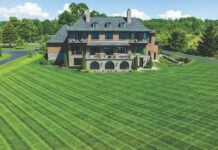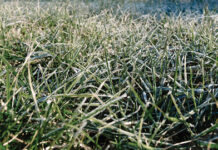“Lawns are a soul-crushing timesuck and most of us would be better off without them.”
How’s that for a headline? This particular one and accompanying opinion piece appeared as a Washington Post Wonkblog this past Aug. 4.
OK, Mr. Christopher Ingraham, the Wonkblog’s author, tell us what you think—really think—about lawns?
What he really thinks is that given the 40 million acres devoted to lawns in the United States, a great majority of the time spent caring for them is time misspent. (In coming up with the lawn acreage number, he referenced a 2005 NASA estimate derived from satellite imaging.)
My immediate impulse on seeing the headline was to tear into this writer like a tiger leaping onto a grazing antelope. I am an editor with Turf magazine, after all, and I have been writing about lawns and their care for more than 30 years. But, as I read and reflected on the article I felt my blood pressure dropping. Apart from the headline (accomplishing what a headline is supposed to do—grab my attention) I found myself agreeing with some of Mr. Ingraham’s points
For example, he makes the point that some people actually enjoy the tasks associated with keeping their lawns nice. Judging by the number of people (neighbors included) I see whizzing around their properties with shiny, efficient riding mowers, I would say a lot of people enjoy working on their lawns. The blogger adds that “in some cases the time investment may be worthwhile–some families use their lawns all the time.” Yep, I can agree with that, too.
In terms of criticism, apart from the time devoted for maintaining them, the Wonkblogger cites the EPA’s estimate that lawns soak up 9 billion gallons of water a day. He has something there. Do we use too many resources–fuel, fertilizers, chemicals and potable water—in caring for our lawns? Unfortunately, too many of us do.
But, in the end, the “timesuck” blog is an opinion piece. It’s not meant to paint a complete or fair picture of the role of lawns in American society.
The blog doesn’t mention the economic value that nicely maintained lawns add to properties. It doesn’t hint at the good will and sense of civility lawns engender in our neighborhoods. But, the biggest omission in the piece is piece is its failure to mention the well-documented environmental plusses lawns contribute to our communities—capturing dust, their cooling effect, reducing runoff, etc.
The role of lawns in American landscapes and how they are cared for has been debated for decades. Lawns and their role in our society will almost certainly continue to be scrutinized well into the future. The discussion is welcome as I’m confident the benefits of having and maintaining lawns far outweigh the criticisms aimed at them.











![[VIDEO] Dickies®: Discover Workwear That’s Anything But Uniform](https://turfmagazine.com/wp-content/uploads/2023/06/1647663814-4b1a2a7742790a9b1e97a3b963477850192e1d6a9dfba9b07214a77bae25d6e3-d-218x150.jpg)




























![[VIDEO] Dickies®: Discover Workwear That’s Anything But Uniform](https://turfmagazine.com/wp-content/uploads/2023/06/1647663814-4b1a2a7742790a9b1e97a3b963477850192e1d6a9dfba9b07214a77bae25d6e3-d-324x160.jpg)
Go to florida. Price a condo in an area with lavish landscaping and lush lawns. Then go 15 minutes down the coast and price a very similar one that has scrubby unirrigated grass and sand around it. The first is $450,000. The latter, $250,000, tops. The monthly fee difference? $100/month. Nobody wants to live around ugly. They pay not to.
The amount of irrigation water, fertilizer, and pesticides needed to maintain a typical small home lot in most places is ridiculously small. I live on 2 acres, but most homes are 1/4 acre or less. 3500 ft of lawn, a few shrubs. No big deal. The problem comes when homeowners douse them in way too much of each. I can’t get some of my customers to stop irrigating lawns daily. They have them running right through rain storms. One deep watering a week is fine for most soils, especially as nature usually supplements this. A $40 bag of fertilizer will last them all year. Or $80 for organics. This is more “save the planet” propaganda designed to subtley imply you’re a bad person if you have a lawn. Inch by inch is how a good propagandist does it.
While I don’t agree with the “time wasting” aspect of this article, I do agree with the fact that we need less lawns. I’m a contractor and sell xeriscape as much as possible. Water is a finite resource and the fact we are dumping it on a non- AG crop is BS. Necesity is the mother of all invention though. It will take our country to get to the point of dehydration or a green lawn, then we will see what we will choose.
NORAHG RESPONDS ABOUT MR RON HALL ― HE SPEAKS THE TRUTH !
We especially appreciate Mr Ron Hall STRIKING back against the RADICAL AND HATEFUL Timesuck Blog. Mr Hall is among several LEADING EXPERTS who have recognized expertise, training and background in matters concerning lawn & landscape management. As a Journalist, Mr Hall has covered the athletic field, golf maintenance, landscaping, and lawn care markets for more than 25 years. Mr Hall is among GREATLY RESPECTED and HIGHLY RATED EXPERTS who promote ENVIRONMENTAL REALISM and PESTICIDE TRUTHS. http://wp.me/p1jq40-8DV Mr Hall is a Commentator, Green Industry Editorial Veteran, Journalist, and Policy Expert on lawn & landscape management, as well as pest control products. He is currently Editor-In-Chief of Turf Magazine and its affiliated brand extensions. Mr Hall has once again effectively spoken out against the lies and mis-information that are spread by those who RECKLESSLY ATTEMPT TO DESTROY the Green Space Industry. Mr Hall SPEAKS THE TRUTH ― and deserves CONGRATULATION. The Whole Truth about Mr Ron Hall, and other experts, can be found on The Pesticide Truths Web-Site … http://wp.me/P1jq40-806 NORAHG is the National Organization Responding Against HUJE that seek to destroy the Green space industry. WILLIAM H GATHERCOLE AND NORAH G http://pesticidetruths.com/
Irrigation systems over water 75% of the lawn with head to head overlapping sprays, wasting billions of gallons every day. Digital sprinklers, based on inkjet technology, stop that waste … they water from the center of the lawn to the shape of lawn with uniform precipitation. No overlap, no spraying on the street.
Spraying water up in the air is wasteful, no matter the type of sprinkler head.
Around here people run their sprinklers in the afternoon sun, just to show off to their neighbors.
Sprinkler systems should be set to run in the wee hours of the morning to minimize loss to evaporation and maximize penetration, and to allow the morning sun to dry the blades of grass to avoid fungus growth.